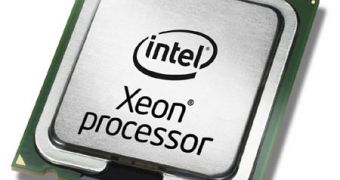Intel's upcoming eight-core Xeon E5 processors that will be based on the company's high-performance Sandy Bridge-EP architecture will sport a TDP of 150W at 3GHz, which may explain why Intel won't launch such CPUs in the desktop space.
This information was spotted in a leaked screenshot of CPU-Z that was running on a dual socket system with two Sandy Bridge-E LGA 2011 processors.
The processors had a base clock speed of 3.0GHz, 20MB of Level 3 cache memory, and each one of them could process up to 16 threads simultaneously, thanks to Intel's HyperThreading technology.
Sadly, the high core count and impressive L3 cache takes its toll on the power consumption of the CPUs as this has a TDP of 150W, according to CPU-Z, which is 20W more than Intel's current flagship, the Core i7-990X.
The same source that provided this screenshot also has a CPU-Z picture of another Sandy Bridge-EP 8-core processor that comes clocked at 2.3GHz and has a TDP of 130W.
If these figures are indeed correct, then this could explain why Intel has no plans to release an eight-core Sandy Bridge-E CPU in the consumer market.
The Xeon E5 processor line will comprise three CPU series, dubbed E5-1600, E5-2600 and E5-4600, and all of these carry a similar feature set, but the latter are compatible with dual-socket and quad-socket motherboards.
Outside of the eight processing cores and 20MB of L3 cache, Sandy Bridge-EP chips also include up to 2 QPI links, 40 PCIe Gen3 lanes, 4 DMI 2.0 lanes, and an integrated quad-channel DDR3 memory controller that support up to three DIMMs per channel for a maximum of 96GB.
Intel's Xeon E5 processor family is expected to arrive in the fourth quarter of this year, while the first desktop Sandy Bridge-E models will be released in Q1 2012. (via Nordic Hardware)

 14 DAY TRIAL //
14 DAY TRIAL // 

